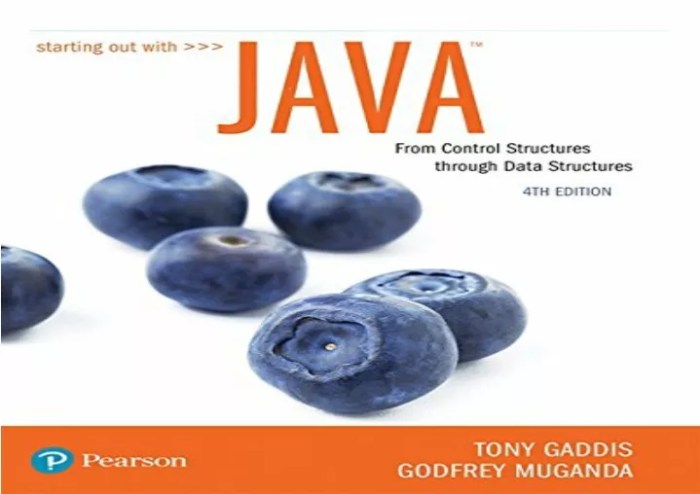Starting out with c++ from control structures through objects pdf – Starting Out with C++: From Control Structures to Objects (PDF) provides a comprehensive introduction to the C++ programming language. This user-friendly guide takes you from the basics of C++ to advanced concepts like classes, objects, and inheritance. With clear explanations and plenty of examples, this book is perfect for beginners and experienced programmers alike.
This book covers all the essential topics of C++, including control structures, functions, arrays, pointers, classes, objects, inheritance, polymorphism, exception handling, input/output, and file handling. It also includes advanced topics such as templates, generic programming, and the Standard Template Library (STL).
1. Introduction to C++: Starting Out With C++ From Control Structures Through Objects Pdf

C++ is a powerful, general-purpose programming language developed by Bjarne Stroustrup in the early 1980s. It is an extension of the C programming language and combines the efficiency and low-level control of C with the object-oriented programming (OOP) capabilities of languages like Simula and Smalltalk.
C++ is widely used in a variety of domains, including operating systems, embedded systems, high-performance computing, and game development. It is known for its performance, flexibility, and the ability to create complex and efficient code.
Key Features of C++
- Object-oriented programming (OOP) capabilities
- Low-level control and memory management
- Efficient and optimized code generation
- Cross-platform compatibility
- Rich standard library
Advantages of C++ over Other Programming Languages, Starting out with c++ from control structures through objects pdf
- Performance: C++ generates efficient code that can run on a wide range of platforms.
- Flexibility: C++ provides both high-level OOP features and low-level control over memory and hardware, making it suitable for a variety of applications.
- Extensibility: C++ allows developers to extend the language with custom libraries and functions.
- Large community: C++ has a large and active community of developers and users, providing support and resources.
Real-World Applications of C++
- Operating systems (e.g., Windows, Linux, macOS)
- Embedded systems (e.g., automotive electronics, medical devices)
- High-performance computing (e.g., scientific simulations, financial modeling)
- Game development (e.g., Unreal Engine, Unity)
- Databases (e.g., MySQL, PostgreSQL)
2. Control Structures
Control structures are used in C++ to control the flow of execution in a program. They allow developers to define the order in which statements are executed and to make decisions based on certain conditions.
Types of Control Structures
- Selection control structures (if-else, switch)
- Loop control structures (for, while, do-while)
Syntax and Usage of Control Structures
Selection Control Structures
The if-else statement allows a program to execute different code blocks based on the evaluation of a condition.
if (condition) // Code to execute if condition is true else // Code to execute if condition is false
The switch statement allows a program to execute different code blocks based on the value of a variable.
switch (variable)
case value1:
// Code to execute if variable equals value1
break;
case value2:
// Code to execute if variable equals value2
break;
default:
// Code to execute if variable does not match any of the cases
break;
Loop Control Structures
The for loop executes a block of code a specified number of times.
for (initialization; condition; increment) // Code to execute
The while loop executes a block of code while a condition is true.
while (condition) // Code to execute
The do-while loop executes a block of code at least once, and then continues to execute it while a condition is true.
do // Code to execute while (condition);
Examples of Control Structures
- Using an if-else statement to check if a user input is valid.
- Using a switch statement to navigate a menu.
- Using a for loop to iterate over an array.
- Using a while loop to continue reading input until a specific character is entered.
- Using a do-while loop to ensure that a certain action is performed at least once.
Essential FAQs
What is C++?
C++ is a general-purpose programming language that is used to develop a wide range of applications, including operating systems, embedded systems, and enterprise software.
What are the benefits of using C++?
C++ is a powerful and efficient programming language that offers a number of benefits, including:
- Speed: C++ is a compiled language, which means that it is converted into machine code before it is run. This makes C++ code very fast.
- Efficiency: C++ is a memory-efficient language, which means that it uses less memory than other programming languages.
- Portability: C++ is a portable language, which means that it can be run on a variety of different operating systems.
Is C++ a good language for beginners?
C++ is a good language for beginners who are interested in learning a powerful and efficient programming language. However, C++ can be a challenging language to learn, so it is important to be patient and to practice regularly.